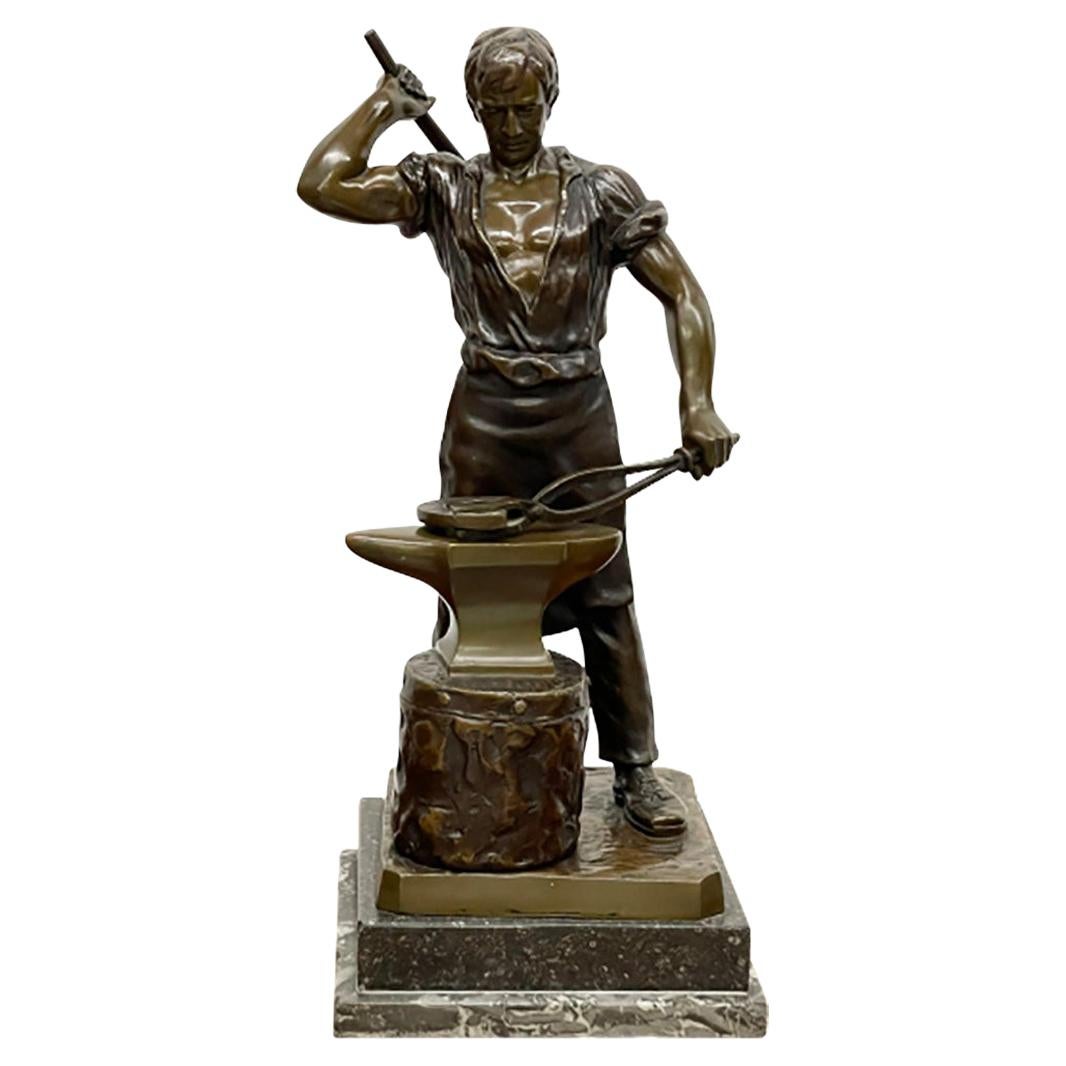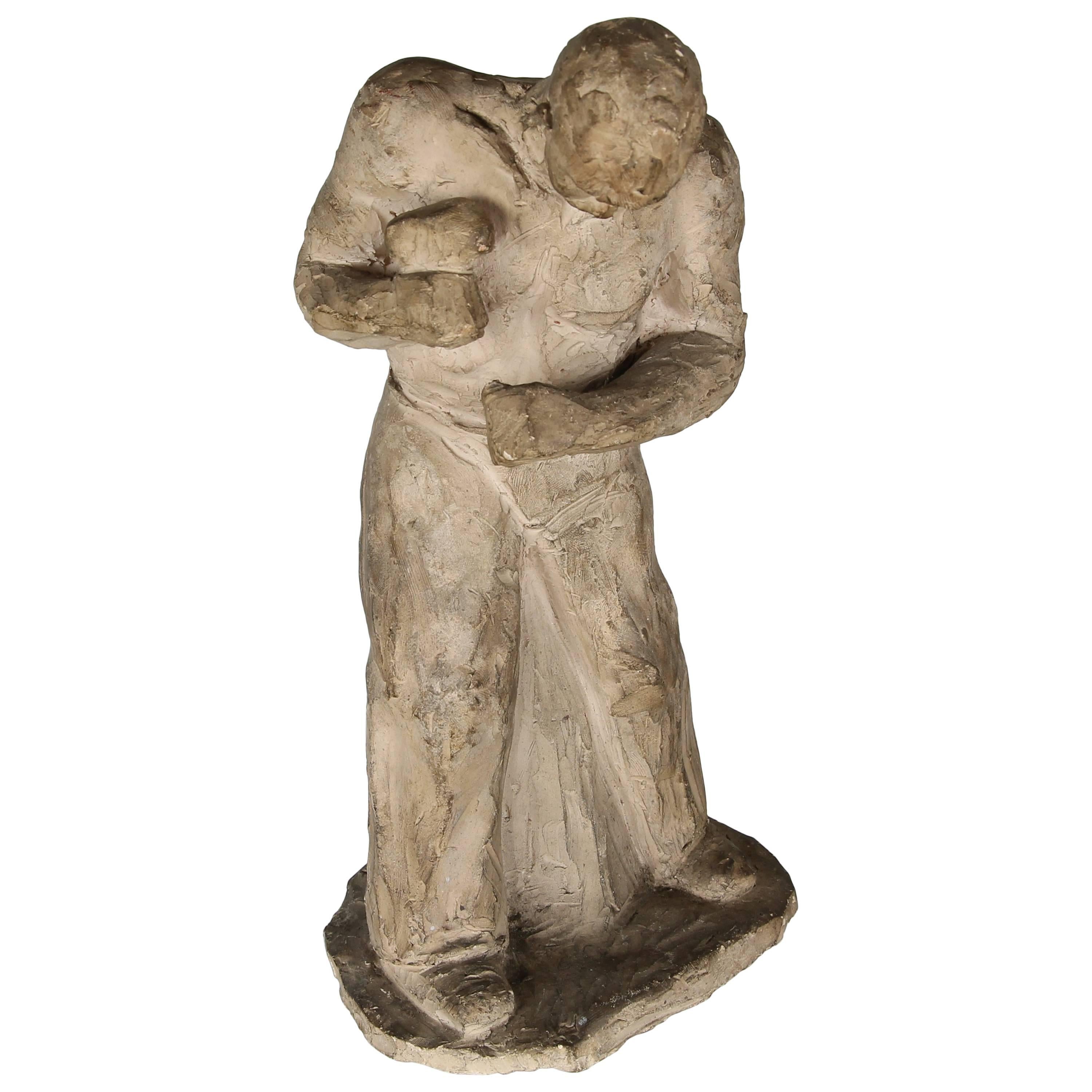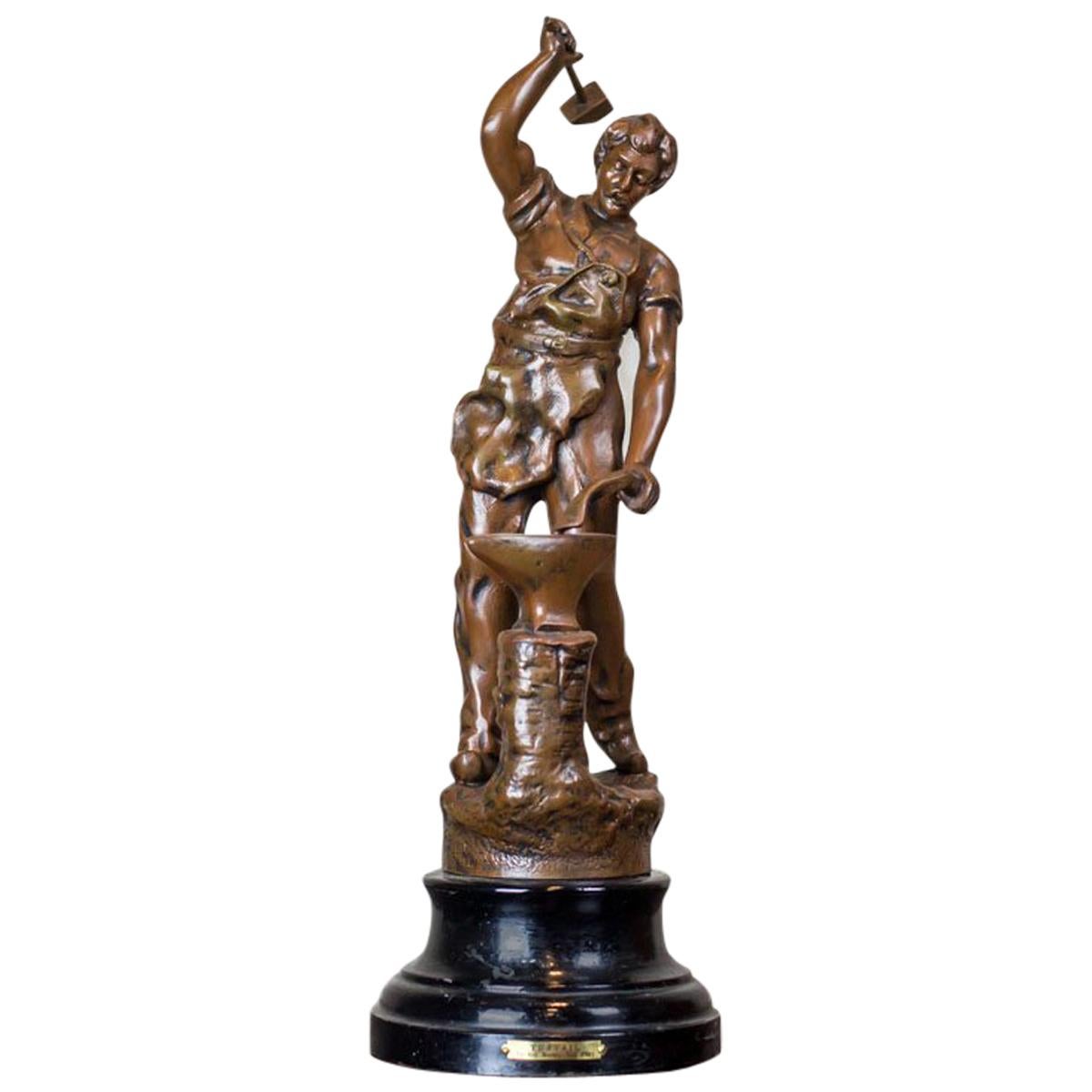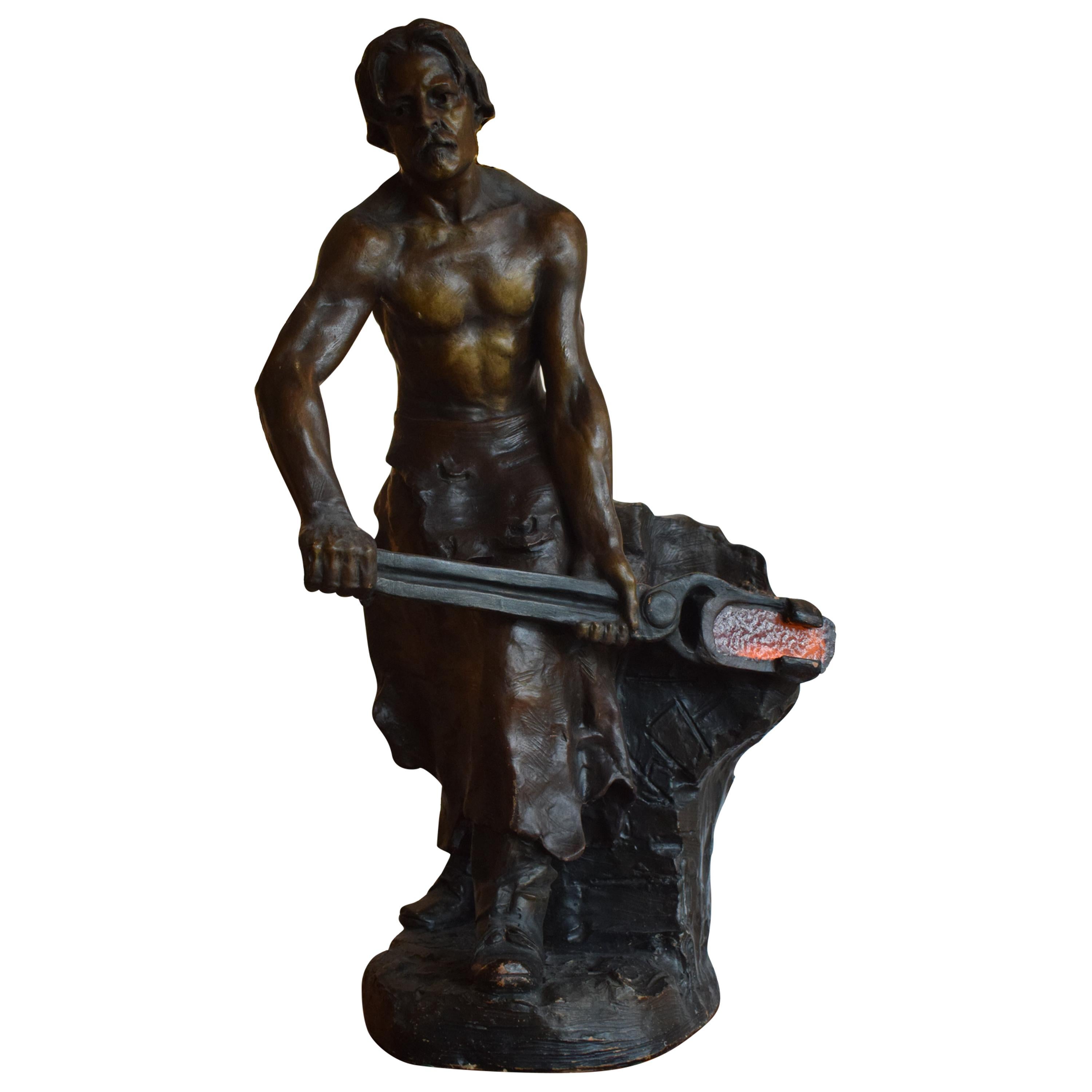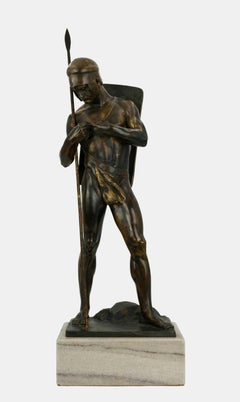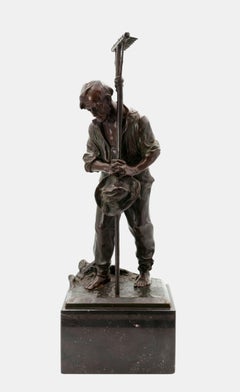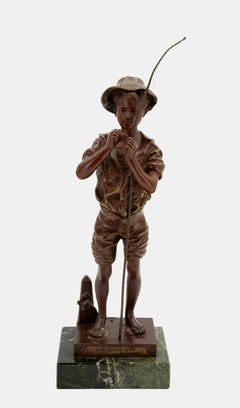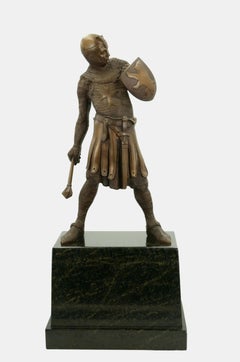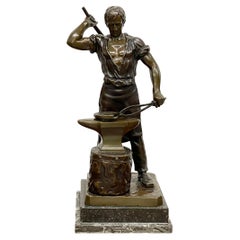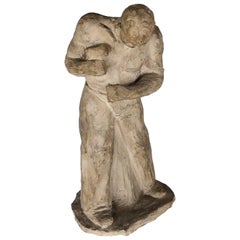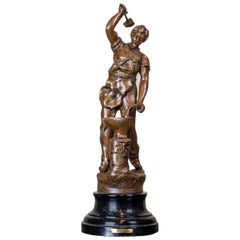Items Similar to The Blacksmith of Solingen / - The Double-edged Sword -
Want more images or videos?
Request additional images or videos from the seller
1 of 8
Wilhelm AlbermannThe Blacksmith of Solingen / - The Double-edged Sword -after 1895
after 1895
$1,675.30
£1,251.27
€1,400
CA$2,308.03
A$2,515.35
CHF 1,331.99
MX$30,211.98
NOK 16,863.23
SEK 15,504.08
DKK 10,665.58
About the Item
Wilhelm Albermann (1835 Werden an der Ruhr - 1913 Cologne), The Blacksmith of Solingen, after 1895. Bronze-color patinated zinc cast on plinth, 47 cm (height) x 20 cm (width) x 16 cm (depth), weight 5.5 kg. Signed “Albermann.” on the plinth and identified as a cast by “AKT.[TIEN] GES.[ELLSCHAFT] GLADENBECK BERLIN”. Dedication on the front: “Mr. Ing. F. Kuhlmann to the wedding. Management and officials of the Hannoversche Waggonfabrik. Aircraft construction department".
- The zinc showing through in spots, the patina somewhat stained, the right upper arm under the sleeve retouched in black.
- The Double-edged Sword -
The figure is a reduction of Wilhelm Albermann's 1895 fountain figure of the armourer of Solingen, who has always been identified with the historical blacksmith Peter Hahn. In 1839, Karl Simrock wrote the poem “The Blacksmith of Solingen" and thus coined the legendary figure. The first and penultimate verses read:
A blacksmith spoke to Solingen
With every bayonet,
That came to his diligence:
"Oh, that Fritz had it!"
The war took its course,
Many battles were fought,
Which often made him fearful and anxious
In his soul.
The blacksmith had given up his trade to fight for Frederick the Great. Not least because of his strength and will to fight, the battles were won. With his fountain sculpture, Albermann has given the legendary blacksmith a figurative form and at the same time created a landmark for the city of Solingen, which was once famous for the art of sword forging and today still stands for the production of high-quality knives. During the bombing raid in November 1944, the fountain was destroyed along with the entire old town of Solingen. Only the head remained.
The broad-shouldered blacksmith stands securely behind his anvil, his leather apron tied around him, and has just finished a sword blade with his own "weapon" - the blacksmith's hammer. His entire body shows the strength with which he wields the hammer, but also the strain of this activity, as evidenced by the wide open shirt, the somewhat 'untidy' apron, and especially the furrowed face.
However, the blacksmith does not look at the finished work, but resolutely and at the same time thoughtfully into the distance, in line with the quoted verse from Simrock's poem that the battles "often made him fearful and anxious in his soul". There is certainly something melancholy in his gaze, fed by the knowledge of the necessity of forging swords and taking up arms and their deadly use - experiences Albermann had to make during his own war missions. The flowing full beard gives his gaze into the distance an almost prophetic character.
In keeping with the craft of the perfectly formed art of blacksmithing, the detailed casting reproduces the respective materials depicted in perfect form: the leather apron convincingly conveys the impression of leather and lies - also in the back view - like a second formed layer over the body, while the shirt and trousers illustrate their own textile qualities.
Due to its masterful execution and profound content, the “Blacksmith of Solingen”, which has survived in its cast reproductions, remains Albermann's most famous work to this day.
About the artist
The son of a carpenter, Wilhelm Albermann began an apprenticeship as a joiner, but then followed his artistic calling and trained as a sculptor in Elberfeld. In 1855, at the age of twenty, he was drafted into the army in Berlin, where he served until 1857. Albermann attended the Berlin Art Academy on the side and began regular studies after his service. While still a student, he completed commissioned works for his teachers August Fischer and Hugo Hagen. His first independent commissions followed, enabling him to establish a flourishing sculpture studio in Cologne in 1865. His artistic activities were repeatedly interrupted by military service, and he took part in the German-Danish War in 1864, the war against Austria in 1866, and the Franco-Prussian War in 1870/71. After his last war service, Albermann, already a respected artist, founded a commercial drawing school at the request of the city government, where he taught the modeling class and served as director until 1896. In 1890 he also worked for the "Society for the Promotion of Sculpture in the Rhineland and Westphalia".
Albermann was one of the most prolific sculptors in Cologne in the second half of the 19th century. He created numerous monuments, fountains, tomb sculptures, architectural ornaments, and domestic statues. At its peak, his workshop employed up to thirty sculptors and stonemasons at a time.
GERMAN VERSION
Wilhelm Albermann (1835 Werden an der Ruhr - 1913 Köln), Der Schmied von Solingen, nach 1895. Bronzefarben patinierter Zinkguss auf gegossener Plinthe, 47 cm (Höhe) x 20 cm (Breite) x 16 cm (Tiefe), Gewicht 5,5 kg. Auf der Plinthe mit „Albermann.“ signiert und als Guss der „AKT.[TIEN] GES.[ELLSCHAFT] GLADENBECK BERLIN“ ausgewiesen. Schauseitige Widmung: „Herrn Ing. F. Kuhlmann zur Vermählung. Direktion und Beamte der Hannoverschen Waggonfabrik. Abt. Flugzeugbau“.
- Punktuelles Durchscheinen des Zinks, Patina etwas fleckig, der rechte Oberarm unter dem Ärmel schwarz retuschiert.
- Die Zweischneidigkeit des Schwertes -
Die Figur ist eine Reduktion von Wilhelm Albermanns 1895 geschaffener Brunnenfigur des Waffenschmieds von Solingen, der seit jeher mit dem historischen Schmied Peter Hahn identifiziert wurde. 1839 hatte Karl Simrock das Gedicht „Der Schmied von Solingen“ verfasst und damit die legendäre Figur geprägt. Die erste und die vorletzte Strophe lauten:
Zu Solingen sprach ein Schmied
Bei jedem Bajonette,
Das seinem Fleiß geriet:
»Ach, daß der Fritz es hätte!«
Der Krieg ging seinen Gang,
Man schlug noch viele Schlachten,
Die oft ihm angst und bang'
In seiner Seele machten.
Der Schmied hatte sein Handwerk ruhen lassen, um selbst für Friedrich den Großen zu kämpfen. Nicht zuletzt durch seine Kraft und seinen Kampfeswillen verliefen die Schlachten siegreich. Dem legendären Schmied verlieht Albermann mit seiner Brunnenskulptur eine bildliche Gestalt und schuf damit zugleich ein Wahrzeichen der Stadt Solingen, die einst für die Kunst des Schwerterschmiedens berühmt war und bis heute für die Herstellung qualitätvoller Messer einsteht. Beim Bombenangriff im November 1944 wurde mit der gesamten Solinger Altstadt auch der Brunnen zerstört. Einzig der Kopf blieb erhalten.
Mit sicherem Stand und umgebundener Lederschürze steht der breitschultrige Schmied hinter seinem Amboss und hat gerade mit seiner eigenen ‚Waffe‘ – dem Schmiedehammer – eine Schwertklinge fertiggestellt. Seinem gesamten Körper ist die Kraft abzulesen, mit der er den Hammer führt, aber auch die Anstrengung dieser Tätigkeit, wovon das weit geöffnete Hemd, die etwas ‚unordentlich‘ arrangierte Schürze und vor allem das zerfurchte Gesicht zeugen.
Der Schmied schaut aber nicht auf das vollendete Werk, sondern entschlossen und zugleich sinnierend in die Ferne, entsprechend der zitierten Zeile von Simrocks Gedicht, dass die Schlachten „oft ihm angst und bang‘ in seiner Seele machten“. Der Blick hat durchaus etwas Melancholisches, dass sich aus dem Wissen um die Notwendigkeit, Schwerter zu schmieden und zu den Waffen zu greifen und deren tödlichem Einsatz speist – Erfahrungen, die Albermann bei seinen eigenen Kriegseinsätze machen musste. Der wallende Vollbart verleiht dem in die Ferne schauenden Blick einen beinahe prophetischen Charakter.
Dem Handwerk der formvollendenden Schmiedekunst entsprechend, gibt der detaillierte Guss die jeweils dargestellten Materialien in vollendeter Ausformung wieder: Die Lederschürze vermittelt überzeugend den Eindruck des Leders und liegt – auch in der Rückenansicht – wie eine zweite ausgeformte Schicht über dem Körper, während das Hemd und die Hose die ihnen eigenen textilen Qualitäten veranschaulichen.
Aufgrund der meisterlichen Ausführung und dem tiefsinnigen Gehalt ist der in seinen gegossenen Reproduktionen erhalten gebliebene „Schmied von Solingen“ bis heute Albermanns berühmtestes Werk.
zum Künstler
Als Sohn eines Schreiners begann Wilhelm Albermann zunächst eine Lehre als Tischler, folgte dann aber seiner künstlerischen Berufung und absolvierte in Elberfeld eine Ausbildung zum Bildschnitzer. Als Zwanzigjähriger wurde er 1855 nach Berlin zum Militär einberufen und diente dort bis 1857. Nebenbei besuchte Albermann die Berliner Kunstakademie und begann nach seiner Dienstzeit ein reguläres Studium. Bereits als Student führte er Auftragsarbeiten für seine Lehrer August Fischer und Hugo Hagen aus. Erste eigenständige Aufträge folgten, die es ihm ermöglichten, 1865 in Köln eine prosperierende Bildhauerwerkstatt einzurichten. Seine künstlerische Tätigkeit wurde immer wieder von Einberufungen unterbrochen, so nahm er 1864 am Deutsch-Dänischen Krieg, 1866 am Krieg gegen Österreich und 1870/71 am Deutsch-Französischen Krieg teil. Im Anschluss an seinen letzten Kriegseinsatz gründete Albermann, der zu dieser Zeit bereits ein angesehener Künstler war, auf Wunsch der Stadtregierung eine Gewerbliche Zeichenschule, an der er die Modellierklasse leitetet und der er bis 1896 als Direktor vorstand. 1890 wurde er zudem für den „Verein zur Förderung der Bildhauerkunst in Rheinland und Westfalen" tätig.
Albermann gehörte in der zweiten Hälfte des 19.jahrhundets zu den produktivsten Kölner Bildhauern. Er schuf zahlreiche Denkmäler, Brunnen, Grabplastiken, architektonischen Schmuck und Statuen für den Wohnbereich. In seiner Werkstatt waren zu Hochzeiten bis zu dreißig Bildhauer und Steinmetze gleichzeitig tätig.
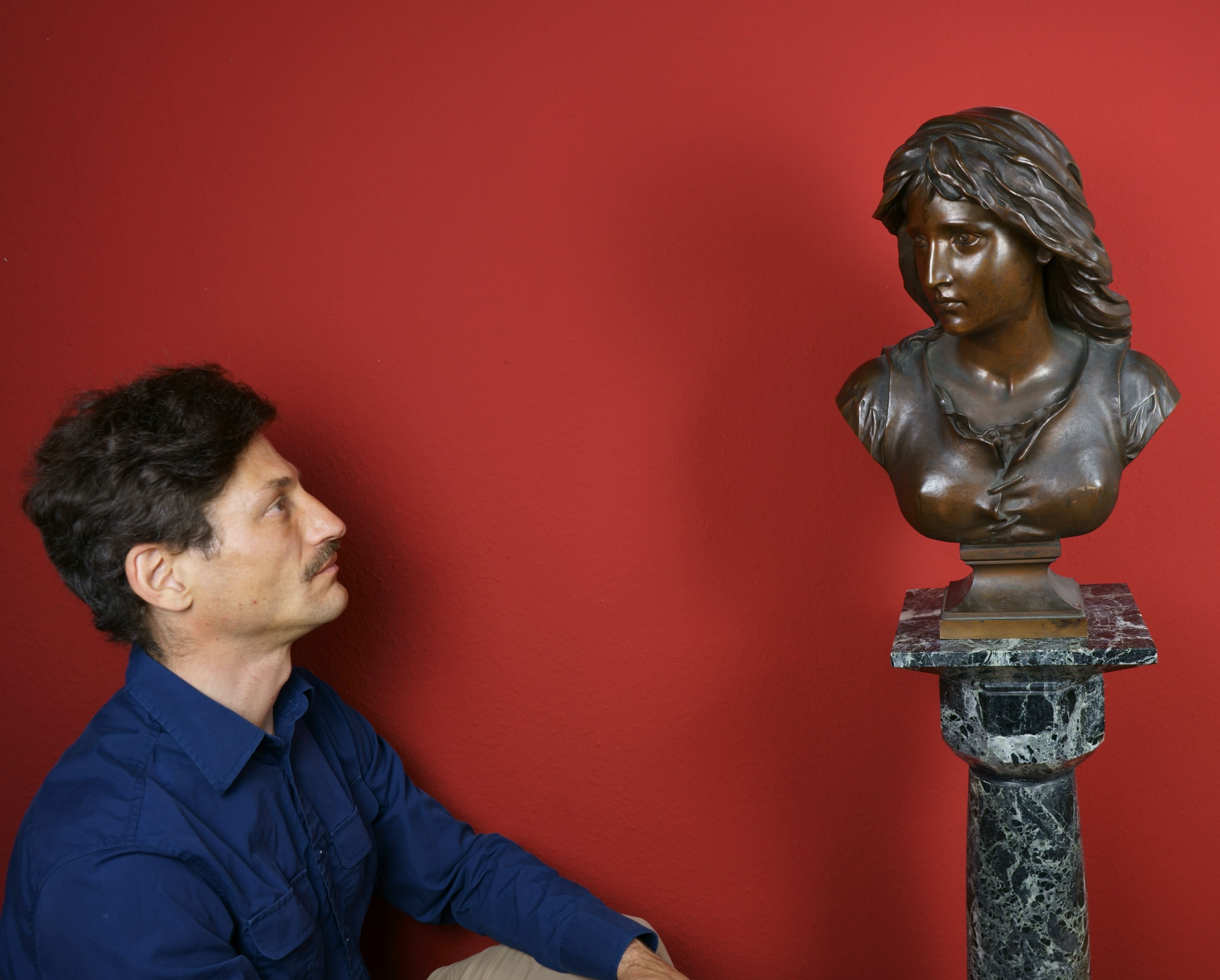
About the Seller
5.0
Vetted Professional Seller
Every seller passes strict standards for authenticity and reliability
Established in 2014
1stDibs seller since 2023
23 sales on 1stDibs
- ShippingRetrieving quote...Shipping from: Berlin, Germany
- Return Policy
More From This Seller
View AllSpear Fighter / - The Fighter's Concentration -
Located in Berlin, DE
Ludwig Eisenberger (active in Berlin between 1895-1920), Spear Fighter, around 1910. Brown patinated bronze with residual gilding on a cast terrain plinth with marble base (8 cm high...
Category
1910s Realist Nude Sculptures
Materials
Bronze
Field worker with rake / - The Humility of the Farm Worker -
Located in Berlin, DE
Paul Ludwig Kowalczewski (1865 Mieltschin - 1910 Berlin), Field worker with rake, around 1900. Brown and brown-greenish patinated bronze with ...
Category
Early 1900s Realist Figurative Sculptures
Materials
Bronze
Pecheur / - Full of anticipation -
Located in Berlin, DE
Adolphe Jean Lavergne (1863-1928), Pecheur, c. 1900. Brown patinated bronze with rectangular cast plinth on a green marble base (3 cm high), total height with hinge 37 cm, width 9 cm, depth 8 cm, weight 2.9 kg, signed “Lavergne” on the plinth.
- Base with old drilling and a few oxidized areas, patina occasionally rubbed, somewhat stained in the folds.
- Full of anticipation -
This bronze is the larger, highly detailed version of the fisherman that made Parisian artist Adolphe Jean Lavergne famous. In preparation for fishing, the boy prepares his rod before heading out to sea. The attachment of the iron ring and the rope behind him suggest a quay wall and a boat moored there. However, the depiction is entirely focused on the actual action of the young fisherman: With equal skill and concentration, he bends a hook to connect it to the fishing line. The contrast with his casual clothing, the loose-fitting trousers, the open shirt with its "wild" folds, and, last but not least, the sun hat boldly perched on his neck, reinforces the impression of the attentive care with which he goes about his work. His gaze makes him appear absorbed, as if he has forgotten the world around him and yet he is visibly filled with anticipation of fishing.
GERMAN VERSION
Adolphe Jean Lavergne (1863-1928), Pecheur, um 1890. Braun patinierte Bronze mit rechteckiger gegossener Plinthe auf grünem Marmorsockel (3 cm Höhe), Gesamthöhe mit Angel 37 cm, Breite 9 cm, Tiefe 8 cm, Gewicht 2,9 kg, auf der Plinthe mit „Lavergne“ signiert.
- Sockel mit alter Bohrung und wenigen oxidierten Stellen, Patina mitunter berieben, in den Falten vereinzelt etwas fleckig.
- Voller Vorfreude -
Die Bronzefigur ist die größere äußerst detaillierte Ausführung des Fischers, mit dem der Pariser Künstler Adolphe Jean Lavergne bekannt geworden ist. In Vorbereitung auf das Fischen präpariert der Junge die Angel...
Category
1890s Realist Figurative Sculptures
Materials
Bronze
$689 Sale Price
20% Off
Crusader with shield and mace / - Ready to strike -
Located in Berlin, DE
Josef Moest (1873 Cologne - 1914 Rath), Crusader with shield and mace, around 1910. Bronze on a black marble pedestal (19 cm high). 57.5 cm (total height) x 21 cm (width) x 12 cm (de...
Category
1910s Realist Figurative Sculptures
Materials
Bronze
Naked warrior with short sword / - The New Hercules -
Located in Berlin, DE
Hermann Volz (1847 Karlsruhe - 1914 ibid.), Naked warrior with short sword, c. 1935. Partially (?) patinated bronze with cast plinth mounted on a black marble base (6.8 cm high). 32....
Category
1930s Art Deco Nude Sculptures
Materials
Bronze
$1,818 Sale Price
20% Off
The Victorious David / - The melancholy of the radiant hero -
Located in Berlin, DE
Henri Honoré Plé (1853 Paris - 1922 Paris), The Victorious David, around1890. Red-brown and brown patinated bronze with terrain plinth mounted on a round base. 42 cm (total height) x...
Category
1890s Realist Figurative Sculptures
Materials
Bronze
$1,818 Sale Price
20% Off
You May Also Like
The Foundry Worker
Located in San Francisco, CA
This sculpture "The Foundry Worker" c.1925 is a bronze sculpture by German artist Albert Caasmann, 1886-1968. The signature is impressed in the bronze. The subject size is 11.15 x 8.15 x 3.15 inches, including marble base, the size is 13.15 x 8.15 x 5 inches. It is in excellent condition.
about the artist:
Albert Caasmann (2 June 1886 – 23 March 1968) was a German sculptor and porcelain artist. Caasmann designed toy figures for the Berlin toy company Lineol and from 1919 to 1952 was the lead designer and production manager for the company. He designed figurines for the porcelain companies Rosenthal AG and Volkstedt. Caasmann's work for the company Rosenthal are exhibited in the Porzellanikon's Rosenthal Museum. Lineol toy figures modeled by Caasmann are in the Historical Toy Museum in Freinsheim and the Toy museum in Havelland.
Albert Caasmann was born on 2 June 1886 in Berlin, Germany. From 1909 to 1919, he worked as a freelancer for the Berlin toy company Lineol, founded by Oskar Wiederholz in 1906. After service as a soldier in the First World War, he became the leading designer and production manager of Lineol from 1919 to 1952. He designed over 600 figures for Lineol, including soldiers, animals, Indians, knights, fairy figures, and railroad figures. His toy figures were widely used in the region by children. Lineol ceased operations in 1965, and in 1985 the company Lineol Duscha has the trademark rights to Lineol. Lineol Duscha reproduces Lineol figures modeled before 1945. Lineol toy figures modeled by Caasmann are in the Historical Toy Museum in Freinsheim and the Toy museum in Havelland.
Caasmann spent time in the Berlin Zoo, where he modeled his animal models. He made a model for a porcelain cheetah...
Category
Early 20th Century Realist Figurative Sculptures
Materials
Bronze
Bronze Statue of a Farrier
Located in Delft, NL
A bronze statue of a farrier.
A male figure in bronze on a black marble base.
The tools are separate parts.
The bronze is signed, not decipherable by whom.
The height of ...
Category
Antique 19th Century German Figurative Sculptures
Materials
Marble, Bronze
Prototype of Blacksmith by Wessel Couzyn
Located in Asbury Park, NJ
A prototype by Dutch sculptor Wessel Couzyn in plaster depicting a blacksmith with hammer. Signed at base.
Couzyn attended the Dutch Royal Academy of Plastic Arts in the late 1930s and was awarded the Prix de Rome in that time to study in Italy. Some bronze works can be found at the Jewish Heritage...
Category
Vintage 1930s Dutch Art Deco Figurative Sculptures
Figurine of a Blacksmith Designed by Auguste Moreau from the 1930s
Located in Opole, PL
We present you a big figurine of bronzed Zamak depicting a blacksmith. This piece of art is based on a draft by Auguste Moreau (casting workshop unknown).
The figurine was created i...
Category
Vintage 1930s French Figurative Sculptures
Materials
Zinc
$526 Sale Price
20% Off
Sculpture of Blacksmith
Located in Atlanta, GA
"Blacksmith" A patinated terracotta sculpture Luminaire signed R. Aurili, France, circa 1920.
Dimensions: Height 29", width 14 1/2", depth 14"
NI243
R. Aurili was a 19th century sculptor who came from Naples and exhibited in the Salon de Paris...
Category
Vintage 1920s French Figurative Sculptures
Materials
Terracotta
$2,600
Marechal Ferrant (The Blacksmith)
By Hermine David
Located in New York, NY
Hermine David (1886-1970), Marechal Ferrant (The Blacksmith), etching and drypoint, signed in pencil lower right [also signed in the plate lower left], ...
Category
1920s Modern Figurative Prints
Materials
Drypoint, Etching
